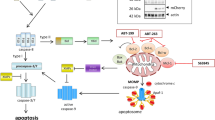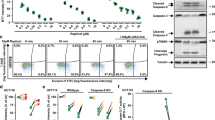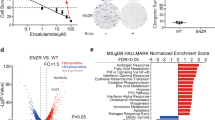Abstract
Death receptors can directly (type I cells) or indirectly induce apoptosis by activating mitochondrial-regulated apoptosis (type II cells). The level of caspase 8 activation is thought to determine whether a cell is type I or II, with type II cells less efficient at activating this caspase following death receptor activation. FLICE-inhibitory protein (FLIP) blocks death receptor-mediated apoptosis by inhibiting caspase 8 activation; therefore, we assessed whether silencing FLIP could convert type II cells into type I. FLIP silencing-induced caspase 8 activation in Bax wild-type and null HCT116 colorectal cancer cells; however, complete caspase 3 processing and apoptosis were only observed in Bax wild-type cells. Bax-null cells were also more resistant to chemotherapy and tumor necrosis factor-related apoptosis inducing ligand and, unlike the Bax wild-type cells, were not sensitized to these agents by FLIP silencing. Further analyses indicated that release of second mitochondrial activator of caspases from mitochondria and subsequent inhibition of X-linked inhibitor of apoptosis protein (XIAP) was required to induce full caspase 3 processing and apoptosis following FLIP silencing. These results indicate that silencing FLIP does not necessarily bypass the requirement for mitochondrial involvement in type II cells. Furthermore, targeting FLIP and XIAP may represent a therapeutic strategy for the treatment of colorectal tumors with defects in mitochondrial-regulated apoptosis.
This is a preview of subscription content, access via your institution
Access options
Subscribe to this journal
Receive 50 print issues and online access
$259.00 per year
only $5.18 per issue
Buy this article
- Purchase on Springer Link
- Instant access to full article PDF
Prices may be subject to local taxes which are calculated during checkout





Similar content being viewed by others
References
Adams JM, Cory S . (2007). The Bcl-2 apoptotic switch in cancer development and therapy. Oncogene 26: 1324–1337.
Arango D, Wilson AJ, Shi Q, Corner GA, Aranes MJ, Nicholas C et al. (2004). Molecular mechanisms of action and prediction of response to oxaliplatin in colorectal cancer cells. Br J Cancer 91: 1931–1946.
Ashkenazi A, Dixit VM . (1998). Death receptors: signaling and modulation. Science 281: 1305–1308.
Berger AB, Sexton KB, Bogyo M . (2006). Commonly used caspase inhibitors designed based on substrate specificity profiles lack selectivity. Cell Res 16: 961–963.
Bratton SB, Cohen GM . (2003). Death receptors leave a caspase footprint that Smacs of XIAP. Cell Death Differ 10: 4–6.
Broaddus VC, Dansen TB, Abayasiriwardana KS, Wilson SM, Finch AJ, Swigart LB et al. (2005). Bid mediates apoptotic synergy between tumor necrosis factor-related apoptosis-inducing ligand (TRAIL) and DNA damage. J Biol Chem 280: 12486–12493.
Chai J, Du C, Wu JW, Kyin S, Wang X, Shi Y . (2000). Structural and biochemical basis of apoptotic activation by Smac/DIABLO. Nature 406: 855–862.
Cummins JM, Kohli M, Rago C, Kinzler KW, Vogelstein B, Bunz F . (2004). X-linked inhibitor of apoptosis protein (XIAP) is a nonredundant modulator of tumor necrosis factor-related apoptosis-inducing ligand (TRAIL)-mediated apoptosis in human cancer cells. Cancer Res 64: 3006–3008.
Dean EJ, Ranson M, Blackhall F, Dive C . (2007). X-linked inhibitor of apoptosis protein as a therapeutic target. Expert Opin Ther Targets 11: 1459–1471.
Deng Y, Lin Y, Wu X . (2002). TRAIL-induced apoptosis requires Bax-dependent mitochondrial release of Smac/DIABLO. Genes Dev 16: 33–45.
Deveraux QL, Reed JC . (1999). IAP family proteins—suppressors of apoptosis. Genes Dev 13: 239–252.
Du C, Fang M, Li Y, Li L, Wang X . (2000). Smac, a mitochondrial protein that promotes cytochrome c-dependent caspase activation by eliminating IAP inhibition. Cell 102: 33–42.
Ekert PG, Silke J . (2001). Till death do us part. Cell Death Differ 8: 662–664.
Ferreira CG, van der Valk P, Span SW, Ludwig I, Smit EF, Kruyt FA et al. (2001). Expression of X-linked inhibitor of apoptosis as a novel prognostic marker in radically resected non-small cell lung cancer patients. Clin Cancer Res 7: 2468–2474.
Galligan L, Longley DB, McEwan M, Wilson TR, McLaughlin K, Johnston PG . (2005). Chemotherapy and TRAIL-mediated colon cancer cell death: the roles of p53, TRAIL receptors, and c-FLIP. Mol Cancer Ther 4: 2026–2036.
Guo F, Nimmanapalli R, Paranawithana S, Wittman S, Griffin D, Bali P et al. (2002). Ectopic overexpression of second mitochondria-derived activator of caspases (Smac/DIABLO) or cotreatment with N-terminus of Smac/DIABLO peptide potentiates epothilone B derivative-(BMS 247550) and Apo-2L/TRAIL-induced apoptosis. Blood 99: 3419–3426.
Han J, Goldstein LA, Gastman BR, Rabinovitz A, Wang GQ, Fang B et al. (2004). Differential involvement of Bax and Bak in TRAIL-mediated apoptosis of leukemic T cells. Leukemia 18: 1671–1680.
Hu Y, Cherton-Horvat G, Dragowska V, Baird S, Korneluk RG, Durkin JP et al. (2003). Antisense oligonucleotides targeting XIAP induce apoptosis and enhance chemotherapeutic activity against human lung cancer cells in vitro and in vivo. Clin Cancer Res 9: 2826–2836.
Hyer ML, Croxton R, Krajewska M, Krajewski S, Kress CL, Lu M et al. (2005). Synthetic triterpenoids cooperate with tumor necrosis factor-related apoptosis-inducing ligand to induce apoptosis of breast cancer cells. Cancer Res 65: 4799–4808.
Jansson A, Sun XF . (2002). Bax expression decreases significantly from primary tumor to metastasis in colorectal cancer. J Clin Oncol 20: 811–816.
Jonsson G, Paulie S, Grandien A . (2003). High level of cFLIP correlates with resistance to death receptor-induced apoptosis in bladder carcinoma cells. Anticancer Res 23: 1213–1218.
Kang SY, Han JH, Lee KJ, Choi JH, Park JI, Kim HI et al. (2007). Low expression of Bax predicts poor prognosis in patients with locally advanced esophageal cancer treated with definitive chemoradiotherapy. Clin Cancer Res 13: 4146–4153.
Kim SH, Kim K, Kwagh JG, Dicker DT, Herlyn M, Rustgi AK et al. (2004). Death induction by recombinant native TRAIL and its prevention by a caspase 9 inhibitor in primary human esophageal epithelial cells. J Biol Chem 279: 40044–40052.
Kischkel FC, Hellbardt S, Behrmann I, Germer M, Pawlita M, Krammer PH et al. (1995). Cytotoxicity-dependent APO-1 (Fas/CD95)-associated proteins form a death-inducing signaling complex (DISC) with the receptor. Embo J 14: 5579–5588.
Krajewska M, Krajewski S, Banares S, Huang X, Turner B, Bubendorf L et al. (2003). Elevated expression of inhibitor of apoptosis proteins in prostate cancer. Clin Cancer Res 9: 4914–4925.
Kroemer G, Reed JC . (2000). Mitochondrial control of cell death. Nat Med 6: 513–519.
LaCasse EC, Cherton-Horvat GG, Hewitt KE, Jerome LJ, Morris SJ, Kandimalla ER et al. (2006). Preclinical characterization of AEG35156/GEM 640, a second-generation antisense oligonucleotide targeting X-linked inhibitor of apoptosis. Clin Cancer Res 12: 5231–5241.
LeBlanc H, Lawrence D, Varfolomeev E, Totpal K, Morlan J, Schow P et al. (2002). Tumor-cell resistance to death receptor-induced apoptosis through mutational inactivation of the proapoptotic Bcl-2 homolog Bax. Nat Med 8: 274–281.
Li H, Zhu H, Xu CJ, Yuan J . (1998). Cleavage of BID by caspase 8 mediates the mitochondrial damage in the Fas pathway of apoptosis. Cell 94: 491–501.
Li M, Song T, Yin ZF, Na YQ . (2007). XIAP as a prognostic marker of early recurrence of nonmuscular invasive bladder cancer. Chin Med J (Engl) 120: 469–473.
Longley DB, Wilson TR, McEwan M, Allen WL, McDermott U, Galligan L et al. (2006). c-FLIP inhibits chemotherapy-induced colorectal cancer cell death. Oncogene 25: 838–848.
Mathas S, Lietz A, Anagnostopoulos I, Hummel F, Wiesner B, Janz M et al. (2004). c-FLIP mediates resistance of Hodgkin/Reed-Sternberg cells to death receptor-induced apoptosis. J Exp Med 199: 1041–1052.
Mizutani Y, Nakanishi H, Li YN, Matsubara H, Yamamoto K, Sato N et al. (2007). Overexpression of XIAP expression in renal cell carcinoma predicts a worse prognosis. Int J Oncol 30: 919–925.
Ozoren N, El-Deiry WS . (2002). Defining characteristics of Types I and II apoptotic cells in response to TRAIL. Neoplasia 4: 551–557.
Ozoren N, Kim K, Burns TF, Dicker DT, Moscioni AD, El-Deiry WS . (2000). The caspase 9 inhibitor Z-LEHD-FMK protects human liver cells while permitting death of cancer cells exposed to tumor necrosis factor-related apoptosis-inducing ligand. Cancer Res 60: 6259–6265.
Ryu BK, Lee MG, Chi SG, Kim YW, Park JH . (2001). Increased expression of cFLIP(L) in colonic adenocarcinoma. J Pathol 194: 15–19.
Scaffidi C, Fulda S, Srinivasan A, Friesen C, Li F, Tomaselli KJ et al. (1998). Two CD95 (APO-1/Fas) signaling pathways. Embo J 17: 1675–1687.
Scaffidi C, Schmitz I, Krammer PH, Peter ME . (1999). The role of c-FLIP in modulation of CD95-induced apoptosis. J Biol Chem 274: 1541–1548.
Schimmer AD, Pedersen IM, Kitada S, Eksioglu-Demiralp E, Minden MD, Pinto R et al. (2003). Functional blocks in caspase activation pathways are common in leukemia and predict patient response to induction chemotherapy. Cancer Res 63: 1242–1248.
Slee EA, Harte MT, Kluck RM, Wolf BB, Casiano CA, Newmeyer DD et al. (1999). Ordering the cytochrome c-initiated caspase cascade: hierarchical activation of caspases-2, -3, -6, -7, -8, and -10 in a caspase-9-dependent manner. J Cell Biol 144: 281–292.
Sun XM, Bratton SB, Butterworth M, MacFarlane M, Cohen GM . (2002). Bcl-2 and Bcl-xL inhibit CD95-mediated apoptosis by preventing mitochondrial release of Smac/DIABLO and subsequent inactivation of X-linked inhibitor-of-apoptosis protein. J Biol Chem 277: 11345–11351.
Tamm I, Richter S, Scholz F, Schmelz K, Oltersdorf D, Karawajew L et al. (2004). XIAP expression correlates with monocytic differentiation in adult de novo AML: impact on prognosis. Hematol J 5: 489–495.
Theodorakis P, Lomonosova E, Chinnadurai G . (2002). Critical requirement of BAX for manifestation of apoptosis induced by multiple stimuli in human epithelial cancer cells. Cancer Res 62: 3373–3376.
Valnet-Rabier MB, Challier B, Thiebault S, Angonin R, Margueritte G, Mougin C et al. (2005). c-Flip protein expression in Burkitt's lymphomas is associated with a poor clinical outcome. Br J Haematol 128: 767–773.
Verdine GL, Walensky LD . (2007). The challenge of drugging undruggable targets in cancer: lessons learned from targeting BCL-2 family members. Clin Cancer Res 13: 7264–7270.
von Haefen C, Gillissen B, Hemmati PG, Wendt J, Guner D, Mrozek A et al. (2004). Multidomain Bcl-2 homolog Bax but not Bak mediates synergistic induction of apoptosis by TRAIL and 5-FU through the mitochondrial apoptosis pathway. Oncogene 23: 8320–8332.
Wang S, El-Deiry WS . (2003). Requirement of p53 targets in chemosensitization of colonic carcinoma to death ligand therapy. Proc Natl Acad Sci USA 100: 15095–15100.
Wang X . (2001). The expanding role of mitochondria in apoptosis. Genes Dev 15: 2922–2933.
Werner AB, de Vries E, Tait SW, Bontjer I, Borst J . (2002). TRAIL receptor and CD95 signal to mitochondria via FADD, caspase-8/10, Bid, and Bax but differentially regulate events downstream from truncated Bid. J Biol Chem 277: 40760–40767.
Wilson TR, McLaughlin KM, McEwan M, Sakai H, Rogers KM, Redmond KM et al. (2007). c-FLIP: a key regulator of colorectal cancer cell death. Cancer Res 67: 5754–5762.
Yeh WC, Itie A, Elia AJ, Ng M, Shu HB, Wakeham A et al. (2000). Requirement for Casper (c-FLIP) in regulation of death receptor-induced apoptosis and embryonic development. Immunity 12: 633–642.
Zhang L, Yu J, Park BH, Kinzler KW, Vogelstein B . (2000). Role of BAX in the apoptotic response to anticancer agents. Science 290: 989–992.
Zhou XD, Yu JP, Liu J, Luo HS, Chen HX, Yu HG . (2004). Overexpression of cellular FLICE-inhibitory protein (FLIP) in gastric adenocarcinoma. Clin Sci (Lond) 106: 397–405.
Zou H, Li Y, Liu X, Wang X . (1999). An APAF-1.cytochrome c multimeric complex is a functional apoptosome that activates procaspase-9. J Biol Chem 274: 11549–11556.
Acknowledgements
This study was supported by: Cancer Research UK, the Medical Research Council and the Ulster Cancer Foundation.
Author information
Authors and Affiliations
Corresponding author
Additional information
Supplementary Information accompanies the paper on the Oncogene website (http://www.nature.com/onc)
Supplementary information
Rights and permissions
About this article
Cite this article
Wilson, T., McEwan, M., McLaughlin, K. et al. Combined inhibition of FLIP and XIAP induces Bax-independent apoptosis in type II colorectal cancer cells. Oncogene 28, 63–72 (2009). https://doi.org/10.1038/onc.2008.366
Received:
Revised:
Accepted:
Published:
Issue Date:
DOI: https://doi.org/10.1038/onc.2008.366
Keywords
This article is cited by
-
Therapeutic approaches targeting CD95L/CD95 signaling in cancer and autoimmune diseases
Cell Death & Disease (2022)
-
Stress-induced TRAILR2 expression overcomes TRAIL resistance in cancer cell spheroids
Cell Death & Differentiation (2020)
-
The SCFSkp2 ubiquitin ligase complex modulates TRAIL-R2-induced apoptosis by regulating FLIP(L)
Cell Death & Differentiation (2020)
-
Convergence of pathway analysis and pattern recognition predicts sensitization to latest generation TRAIL therapeutics by IAP antagonism
Cell Death & Differentiation (2020)
-
RALB GTPase: a critical regulator of DR5 expression and TRAIL sensitivity in KRAS mutant colorectal cancer
Cell Death & Disease (2020)



